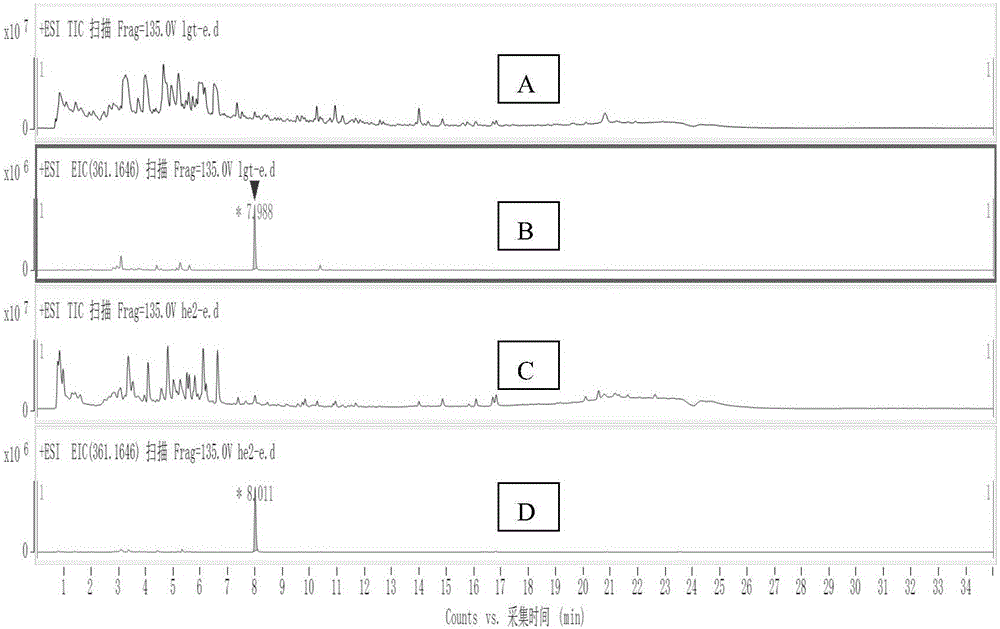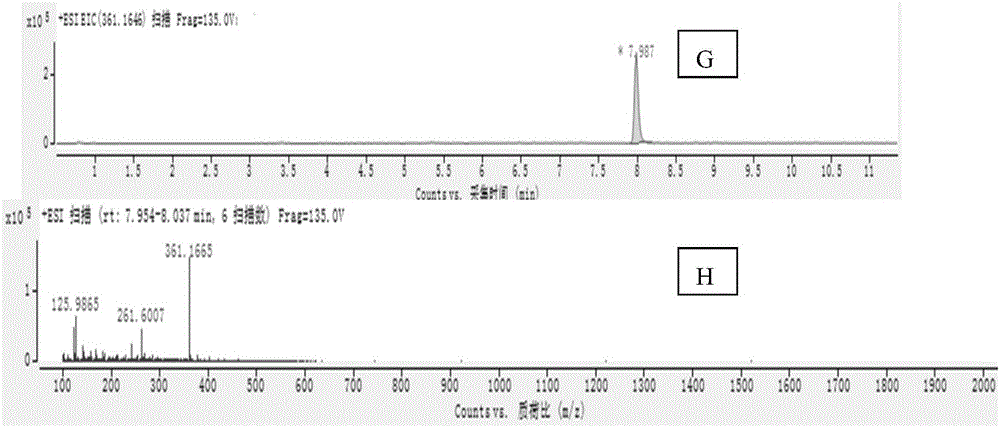Application of triptolide in identification presence of tripterygium glycoside honey in honey as feature identification material
A technology of triptolide and feature recognition, which is applied in the direction of measuring devices, instruments, scientific instruments, etc., to achieve the effect of easy acquisition, simple and convenient honey sample pretreatment method, and easy operation
- Summary
- Abstract
- Description
- Claims
- Application Information
AI Technical Summary
Problems solved by technology
Method used
Image
Examples
experiment example
[0056] 1. Experimental materials: tripterygium twig honey, whole flower of tripterygium twig, rape honey, acacia honey, wattle honey, linden tree honey, jujube flower honey, multifloral honey.
[0057] Among them, Tripterygium wilfordii honey is obtained through the following method: In the Xinxiang bee farm in Henan Province, select the area where Tripterygium wilfordii is planted, place the bee farm in a sealed area that can be collected, remove other nearby honey sources by artificial means, and let the bees collect Tripterygium wilfordii honey , collected for a week, shake out the honey from the beehive, take 100g, clear the honeycomb, and destroy other remaining honey.
[0058] 2. Experimental method:
[0059] (1) Prepare the sample to be tested:
[0060] Preparation of honey samples to be tested: take 10g each of Tripterygium wilfordii honey, rape honey, acacia honey, Vitex honey, linden honey, and jujube flower honey, and process them in the following manner respective...
Embodiment 1
[0079] Test samples: More than 130 different samples were taken from the market, including rapeseed, acacia, jujube flower, Vitex twig, litchi, longan, linden tree, mountain flower, buckwheat, etc., 2 of which were suspected to be tripterygium honey (a small amount of tripterygium wilfordii nearby).
[0080] Sample pretreatment: Put 10g of honey into a 50mL centrifuge tube, add 10mL of water to dissolve, then add 20mL of acetonitrile to mediate extraction for 5min, add 4g of anhydrous magnesium sulfate and 1g of sodium chloride into the centrifuge tube, mix for 1min, and centrifuge at 5000rpm for 5min . Take the upper organic phase and dry it with nitrogen gas, redissolve it with 2 mL of 50% aqueous methanol solution, mix it, and filter it with a 0.2 μm filter membrane.
[0081] Detection method: LC / MS / MS method is used for detection (detection limit is 12 μg / kg), and the detection conditions are:
[0082] Chromatographic column: agilentSBC18, 2.1x50mm, 1.8μm;
[0083] Flow ...
Embodiment 2
[0092] Detection sample: with embodiment 1
[0093] Sample pretreatment: Put 10g of honey into a 50mL centrifuge tube, add 10mL of water to dissolve, then add 20mL of 0.2% formic acid methanol solution for mediation and extraction for 8min, add 4g of anhydrous magnesium sulfate and 1g of sodium chloride into the centrifuge tube, and mix for 1min , centrifuge at 5000rpm for 5min. Take the upper organic phase and dry it with nitrogen gas, redissolve it with 2 mL of 50% aqueous methanol solution, mix it, and filter it with a 0.2 μm filter membrane.
[0094] Detection method: LC-Q-TOF method is used for detection, and the detection conditions are the same as the pre-experimental example, the only difference is that the chromatographic column adopts a phenyl column, and the mobile phase is: A methanol, B water.
[0095] Test results: Among the 2 suspected tripterygium honey, triptolide was detected in 1 suspected sample from Fujian, which was confirmed on the spot, but triptolide ...
PUM
 Login to View More
Login to View More Abstract
Description
Claims
Application Information
 Login to View More
Login to View More - R&D
- Intellectual Property
- Life Sciences
- Materials
- Tech Scout
- Unparalleled Data Quality
- Higher Quality Content
- 60% Fewer Hallucinations
Browse by: Latest US Patents, China's latest patents, Technical Efficacy Thesaurus, Application Domain, Technology Topic, Popular Technical Reports.
© 2025 PatSnap. All rights reserved.Legal|Privacy policy|Modern Slavery Act Transparency Statement|Sitemap|About US| Contact US: help@patsnap.com



